The Automotive Steering Knuckle Market is estimated to be valued at USD 7.3 billion in 2025 and is projected to reach USD 11.2 billion by 2035, registering a compound annual growth rate (CAGR) of 4.4% over the forecast period. The market demonstrates a moderately steady growth trajectory, indicating an environment where incremental innovations, material optimization, and cost efficiencies play a central role in competitive positioning. The landscape is dominated by established OEM suppliers who leverage long-standing relationships with automakers, scale advantages, and robust supply chain integration to maintain market share. Yearly value progression from USD 7.3 billion in 2025 to USD 11.2 billion in 2035 reflects consistent growth, highlighting that companies with advanced metallurgical capabilities, lightweight design expertise, and precision manufacturing experience are positioned to capture disproportionate value gains.
Smaller players face challenges from high capital intensity, strict quality standards, and the need for compliance with evolving safety and performance regulations, which reinforces market consolidation tendencies over the forecast period. Regional differentiation shapes competitive dynamics, with Asia-Pacific emerging as a high-growth arena due to increasing automotive production volumes, whereas Europe and North America maintain a focus on premium and high-performance vehicle segments. The competitive landscape thus combines established scale advantages, technological differentiation, and regional market strategies, underlining that sustained market share is increasingly linked to innovation in lightweight alloys, machining precision, and alignment with automakers’ electrification and efficiency agendas.
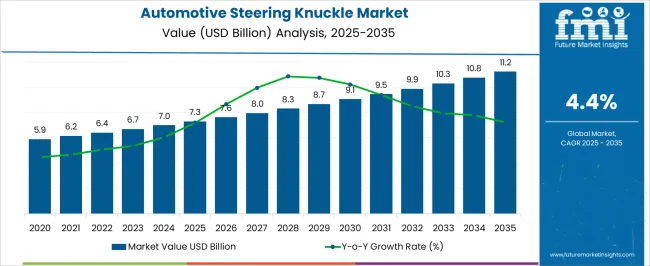
| Metric | Value |
|---|---|
| Automotive Steering Knuckle Market Estimated Value in (2025 E) | USD 7.3 billion |
| Automotive Steering Knuckle Market Forecast Value in (2035 F) | USD 11.2 billion |
| Forecast CAGR (2025 to 2035) | 4.4% |
The automotive steering knuckle market is expanding steadily, propelled by the growth in passenger vehicle production and increasing focus on vehicle safety and performance. The rising demand for passenger cars globally, especially in developing regions, has fueled the need for reliable steering components that ensure precise handling and durability.
Innovations in vehicle design and the push for lighter yet stronger materials have influenced material selection and manufacturing processes in the market. The increased adoption of cast iron, driven by its strength and cost-effectiveness, continues to support segment growth.
Additionally, casting remains the preferred manufacturing process due to its ability to produce complex shapes efficiently and economically. The growing automotive aftermarket and rising vehicle ownership rates are also driving demand for replacement steering knuckles. As manufacturers invest in advanced manufacturing techniques and material improvements, the market outlook remains positive, with growth expected to be led by passenger cars, cast iron materials, and casting processes.
The automotive steering knuckle market is segmented by vehicle, material, manufacturing process, application, sales channel, and geographic regions. By vehicle, the automotive steering knuckle market is divided into Passenger cars, Heavy Commercial Vehicles (HCVs), and Mining equipment. In terms of material, the automotive steering knuckle market is classified into Cast iron, Steel, Aluminum, and Others. Based on manufacturing process, the automotive steering knuckle market is segmented into Casting, Forging, Machining, and Others. By application, the automotive steering knuckle market is segmented into Front steering knuckles and Rear steering knuckles. By sales channel, the automotive steering knuckle market is segmented into OEM and Aftermarket. Regionally, the automotive steering knuckle industry is classified into North America, Latin America, Western Europe, Eastern Europe, Balkan & Baltic Countries, Russia & Belarus, Central Asia, East Asia, South Asia & Pacific, and the Middle East & Africa.
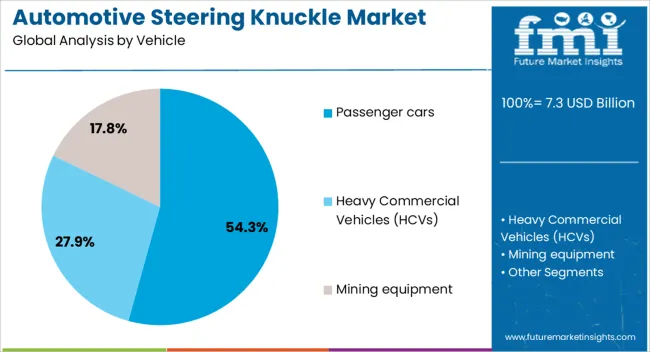
The passenger cars segment is expected to account for 54.3% of the automotive steering knuckle market revenue in 2025, maintaining its position as the dominant vehicle category. This segment’s expansion is linked to the steady increase in passenger vehicle production worldwide and the consumer preference for comfortable, safe, and high-performance vehicles.
Passenger cars require durable steering components to support precise maneuverability and safety standards. The growth in urbanization and disposable incomes in emerging markets has further boosted passenger car sales, which in turn has fueled demand for steering knuckles.
Continued advancements in vehicle design and safety regulations are expected to sustain the growth of the passenger cars segment.

The cast iron segment is projected to contribute 47.8% of the automotive steering knuckle market revenue in 2025, securing its place as the leading material choice. Cast iron has been favored due to its excellent mechanical strength, wear resistance, and cost efficiency.
The material’s ability to absorb vibrations and withstand harsh operating conditions has made it the preferred option for steering knuckles in many vehicles. Additionally, cast iron can be easily cast into complex shapes required for steering knuckles, supporting mass production.
Despite the emergence of lightweight materials, cast iron remains widely used due to its reliability and affordability, particularly in cost-sensitive vehicle segments.
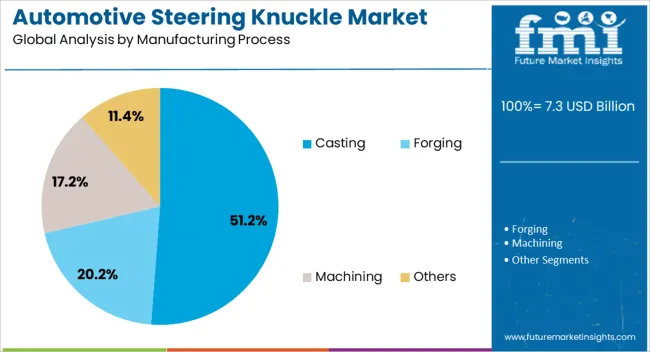
The casting segment is expected to hold 51.2% of the automotive steering knuckle market revenue in 2025, maintaining its dominance as the preferred manufacturing process. Casting offers the advantage of producing complex and precise shapes with high repeatability, essential for the intricate geometry of steering knuckles.
This process allows manufacturers to achieve tight tolerances and high structural integrity while optimizing production costs. The scalability of casting makes it suitable for both original equipment manufacturing and aftermarket production.
Advances in casting technologies have further improved the quality and consistency of steering knuckles. As production volumes rise with increasing vehicle demand, casting is projected to remain the leading manufacturing process in this market.
The market has been expanding due to increasing demand for durable, lightweight, and high-performance components in passenger vehicles, commercial vehicles, and electric vehicles. Steering knuckles have been widely utilized to connect suspension components, wheel hubs, and steering systems, ensuring stability, safety, and precise handling. Market growth has been supported by advancements in lightweight alloys, high-strength steel, and manufacturing technologies. Rising vehicle production, adoption of advanced driver assistance systems, and the shift toward electric mobility have further strengthened the demand for automotive steering knuckles globally.
The rising emphasis on vehicle safety, stability, and handling has been a major driver of the automotive steering knuckle market. Steering knuckles play a critical role in connecting wheel hubs, suspension components, and steering systems, enabling precise control and directional stability. High-performance steering knuckles are designed to withstand dynamic loads, vibrations, and impacts, improving ride quality and driver confidence. Passenger vehicles, SUVs, and commercial trucks have increasingly incorporated advanced steering and suspension architectures, prompting demand for robust and lightweight knuckle designs. Additionally, the adoption of electric vehicles and four-wheel-drive systems has required optimized knuckle geometry and materials to support new drivetrain configurations. These trends, combined with rising automotive production worldwide, have reinforced the criticality of steering knuckles in vehicle safety and performance.
Technological innovations and the use of lightweight materials have strengthened the automotive steering knuckle market. High-strength aluminum alloys, forged steel, and composite materials have been employed to reduce unsprung mass, improve fuel efficiency, and maintain structural integrity. Advanced casting, forging, and machining techniques have enabled high-precision components with superior durability and load-bearing capacity. Integration of steering knuckles with advanced suspension systems, electronic stability control, and adaptive steering technologies has further enhanced vehicle handling and safety. Computer-aided design, finite element analysis, and additive manufacturing have facilitated optimized geometries and reduced development cycles. These technological advancements have allowed manufacturers to deliver high-performance steering knuckles suitable for traditional, hybrid, and electric vehicles, driving broader adoption across global automotive markets.
Compliance with vehicle safety regulations and performance standards has been a key factor driving the adoption of high-quality steering knuckles. International automotive safety standards, crashworthiness requirements, and component testing protocols have guided the design, material selection, and manufacturing processes. Steering knuckles must meet stringent requirements for load-bearing capacity, fatigue resistance, and durability to ensure vehicle reliability and passenger safety. Manufacturers have implemented quality assurance, dimensional inspections, and process certifications to comply with regional regulations. With rising enforcement of safety norms and consumer expectations for secure, reliable vehicles, the adoption of robust and technologically advanced steering knuckles has become essential in passenger, commercial, and electric vehicles globally.
The rapid adoption of electric vehicles (EVs) and advanced driver assistance systems (ADAS) has created significant growth opportunities in the automotive steering knuckle market. EVs require lightweight, high-strength steering knuckles to optimize battery efficiency and vehicle dynamics, while ADAS integration demands precise steering and suspension performance. The development of autonomous driving technologies, adaptive steering mechanisms, and four-wheel-drive EV platforms has increased the need for customized knuckle designs with enhanced durability and reliability. Furthermore, the expansion of premium, luxury, and performance vehicle segments has encouraged innovation in material selection and manufacturing processes. As EV adoption and intelligent vehicle systems continue to rise, the demand for high-performance automotive steering knuckles is expected to grow across global automotive markets.
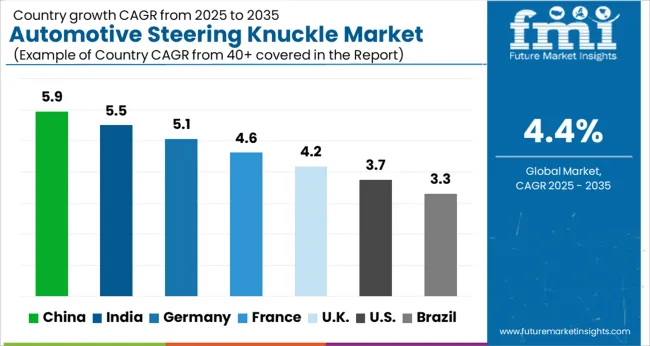
The market is set to grow at a CAGR of 4.4% between 2025 and 2035, driven by increasing vehicle production, demand for lightweight components, and adoption of advanced steering technologies. China leads with a 5.9% CAGR, supported by high automotive manufacturing volumes and growing electric vehicle production. India follows at 5.5%, with growth fueled by rising passenger and commercial vehicle demand. Germany, at 5.1%, benefits from advanced automotive engineering and adoption of innovative materials. The UK, with a 4.2% CAGR, focuses on modern vehicle production and safety standards, while the USA, at 3.7%, experiences steady demand through OEM expansions and replacement markets. This report includes insights on 40+ countries; the top markets are shown here for reference.
The industry in China is anticipated to expand at a CAGR of 5.9% from 2025 to 2035, driven by increasing production of passenger vehicles and commercial trucks. Domestic OEMs are integrating lightweight alloys and high-strength steel in steering knuckle designs to improve performance and reduce vehicle weight. Collaborations with tier-one suppliers have accelerated component standardization and adoption across multiple vehicle platforms. Rising focus on EVs and autonomous vehicles is further stimulating demand for precision-engineered steering components.
The automotive steering knuckle industry in India is projected to grow at a CAGR of 5.5% between 2025 and 2035, supported by rising vehicle production and modernization of manufacturing facilities. Tier-one suppliers are adopting high-precision forging and casting methods to enhance durability and reduce weight. Growth is concentrated in passenger vehicle and light commercial vehicle segments. Manufacturers are also investing in R&D for EV-compatible steering solutions.
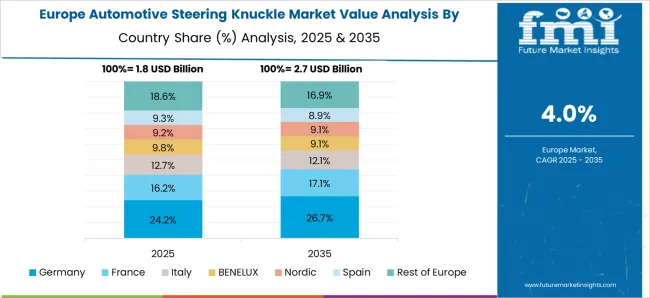
Sales of automotive steering knuckles in Germany are forecast to expand at a CAGR of 5.1% during 2025 to 2035, driven by high-end passenger vehicles and luxury automobile production. Automotive OEMs are focusing on aluminum and magnesium-based knuckles to reduce weight while maintaining structural integrity. Adoption in electric and hybrid vehicle platforms is increasing, supported by government incentives for energy-efficient transport. Key players are investing in precision casting and machining technologies to maintain performance standards.
The automotive steering knuckle industry in the United Kingdom is expected to progress at a CAGR of 4.2% from 2025 to 2035, propelled by modernization of automotive production lines and lightweight vehicle trends. Steel and aluminum knuckles are increasingly adopted in passenger and commercial vehicles. Market growth is further aided by emerging EV platforms requiring precise steering assemblies. Domestic suppliers are focusing on advanced forging and heat treatment processes to meet OEM standards.
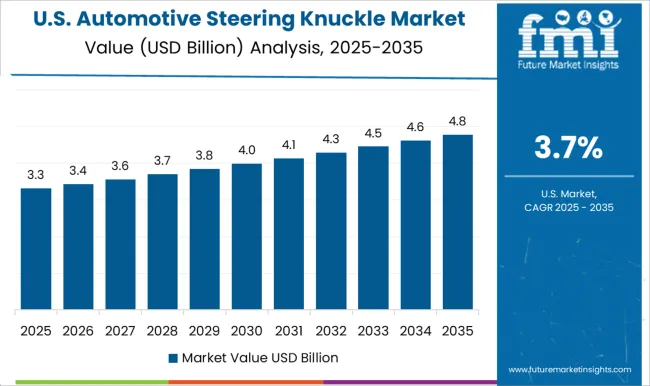
Sales of automotive steering knuckles in the United States are projected to grow at a CAGR of 3.7% between 2025 and 2035, supported by steady vehicle production and growing EV adoption. OEMs are focusing on aluminum and high-strength steel designs to improve durability and reduce vehicle weight. Aftermarket demand for replacement knuckles also contributes to overall growth. Adoption is concentrated in both passenger cars and light trucks.

The market is driven by the need for enhanced vehicle safety, performance, and durability across passenger cars, commercial vehicles, and electric vehicles. Benteler has established a strong presence with high-strength forged and cast components engineered for lightweighting and superior impact resistance. Bharat Forge focuses on advanced forging solutions and integrated manufacturing capabilities, supplying both OEMs and Tier 1 suppliers globally. Bosch and Continental leverage precision engineering and quality control to provide knuckles that meet stringent safety and performance standards, while Dana Incorporated emphasizes optimized designs for diverse vehicle platforms, including EVs and hybrid vehicles.
Magna International combines global manufacturing scale with R&D initiatives, developing knuckles with improved fatigue resistance and corrosion protection. MAT Foundry provides specialized casting solutions for high-performance and heavy-duty vehicles. Nexteer Automotive integrates steering system expertise with knuckle design to enhance vehicle handling and reliability. Thyssenkrupp and ZF Friedrichshafen offer lightweight, high-strength components engineered for modern powertrains and chassis configurations, emphasizing material innovation and process efficiency. Market strategies focus on product development, collaborations with OEMs, and expansion into electric and autonomous vehicle segments. Entry barriers include high capital investment, technical expertise requirements, and compliance with automotive safety standards. Manufacturers capable of delivering high-quality, durable, and lightweight steering knuckles remain well-positioned to capture long-term market growth.
| Item | Value |
|---|---|
| Quantitative Units | USD 7.3 Billion |
| Vehicle | Passenger cars, Heavy Commercial Vehicles (HCVs), and Mining equipment |
| Material | Cast iron, Steel, Aluminum, and Others |
| Manufacturing Process | Casting, Forging, Machining, and Others |
| Application | Front steering knuckle and Rear steering knuckle |
| Sales Channel | OEM and Aftermarket |
| Regions Covered | North America, Europe, Asia-Pacific, Latin America, Middle East & Africa |
| Country Covered | United States, Canada, Germany, France, United Kingdom, China, Japan, India, Brazil, South Africa |
| Key Companies Profiled | Benteler, Bharat Forge, Bosch, Continental, Dana Incorporated, Magna International, MAT Foundry, Nexteer Automotive, Thyssenkrupp, and ZF Friedrichshafen |
| Additional Attributes | Dollar sales by material type and vehicle segment, demand dynamics across passenger cars, commercial vehicles, and electric vehicles, regional trends in production and adoption across North America, Europe, and Asia-Pacific, innovation in lightweight alloys, high-strength castings, and 3D-printed components, environmental impact of material sourcing, manufacturing emissions, and end-of-life recyclability, and emerging use cases in electric and autonomous vehicle suspension systems, performance optimization, and enhanced safety designs. |
The global automotive steering knuckle market is estimated to be valued at USD 7.3 billion in 2025.
The market size for the automotive steering knuckle market is projected to reach USD 11.2 billion by 2035.
The automotive steering knuckle market is expected to grow at a 4.4% CAGR between 2025 and 2035.
The key product types in automotive steering knuckle market are passenger cars, _sedans, _hatchbacks, _suvs, _others, _commercial vehicles, heavy commercial vehicles (hcvs), _off-road vehicles, _construction equipment and mining equipment.
In terms of material, cast iron segment to command 47.8% share in the automotive steering knuckle market in 2025.






Our Research Products

The "Full Research Suite" delivers actionable market intel, deep dives on markets or technologies, so clients act faster, cut risk, and unlock growth.

The Leaderboard benchmarks and ranks top vendors, classifying them as Established Leaders, Leading Challengers, or Disruptors & Challengers.

Locates where complements amplify value and substitutes erode it, forecasting net impact by horizon

We deliver granular, decision-grade intel: market sizing, 5-year forecasts, pricing, adoption, usage, revenue, and operational KPIs—plus competitor tracking, regulation, and value chains—across 60 countries broadly.

Spot the shifts before they hit your P&L. We track inflection points, adoption curves, pricing moves, and ecosystem plays to show where demand is heading, why it is changing, and what to do next across high-growth markets and disruptive tech

Real-time reads of user behavior. We track shifting priorities, perceptions of today’s and next-gen services, and provider experience, then pace how fast tech moves from trial to adoption, blending buyer, consumer, and channel inputs with social signals (#WhySwitch, #UX).

Partner with our analyst team to build a custom report designed around your business priorities. From analysing market trends to assessing competitors or crafting bespoke datasets, we tailor insights to your needs.
Supplier Intelligence
Discovery & Profiling
Capacity & Footprint
Performance & Risk
Compliance & Governance
Commercial Readiness
Who Supplies Whom
Scorecards & Shortlists
Playbooks & Docs
Category Intelligence
Definition & Scope
Demand & Use Cases
Cost Drivers
Market Structure
Supply Chain Map
Trade & Policy
Operating Norms
Deliverables
Buyer Intelligence
Account Basics
Spend & Scope
Procurement Model
Vendor Requirements
Terms & Policies
Entry Strategy
Pain Points & Triggers
Outputs
Pricing Analysis
Benchmarks
Trends
Should-Cost
Indexation
Landed Cost
Commercial Terms
Deliverables
Brand Analysis
Positioning & Value Prop
Share & Presence
Customer Evidence
Go-to-Market
Digital & Reputation
Compliance & Trust
KPIs & Gaps
Outputs
Full Research Suite comprises of:
Market outlook & trends analysis
Interviews & case studies
Strategic recommendations
Vendor profiles & capabilities analysis
5-year forecasts
8 regions and 60+ country-level data splits
Market segment data splits
12 months of continuous data updates
DELIVERED AS:
PDF EXCEL ONLINE
Automotive Steering System Market Growth - Trends & Forecast 2025 to 2035
Automotive Steering Column Market
Automotive Power Steering Hoses and Assemblies Market Size and Share Forecast Outlook 2025 to 2035
Automotive Power Steering Cooler Market
Automotive Electro-hydraulic Power Steering Pumps Market Size and Share Forecast Outlook 2025 to 2035
Automotive Direct Liquid Cooling IGBT Module Market Size and Share Forecast Outlook 2025 to 2035
Automotive Hoses and Assemblies Market Size and Share Forecast Outlook 2025 to 2035
Automotive Network Testing Market Size and Share Forecast Outlook 2025 to 2035
Automotive Performance Part Market Size and Share Forecast Outlook 2025 to 2035
Automotive Carbon Ceramic Brake Market Size and Share Forecast Outlook 2025 to 2035
Automotive Camshaft Market Size and Share Forecast Outlook 2025 to 2035
Automotive Stamping Industry Analysis in India Size and Share Forecast Outlook 2025 to 2035
Automotive Cylinder Liner Market Size and Share Forecast Outlook 2025 to 2035
Automotive Microcontroller Market Size and Share Forecast Outlook 2025 to 2035
Automotive Roof Rails Market Size and Share Forecast Outlook 2025 to 2035
Automotive Active Safety System Market Size and Share Forecast Outlook 2025 to 2035
Automotive Diagnostic Scan Tool Market Size and Share Forecast Outlook 2025 to 2035
Automotive Test Equipment Market Size and Share Forecast Outlook 2025 to 2035
Automotive Dynamic Map Data Market Size and Share Forecast Outlook 2025 to 2035
Automotive Green Tires Market Size and Share Forecast Outlook 2025 to 2035

Thank you!
You will receive an email from our Business Development Manager. Please be sure to check your SPAM/JUNK folder too.
Chat With
MaRIA